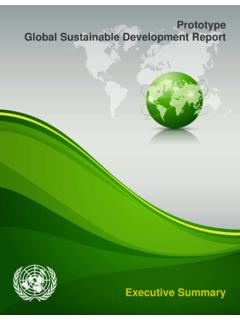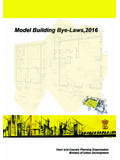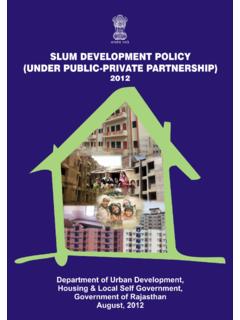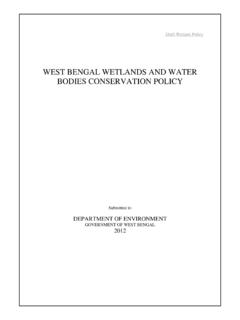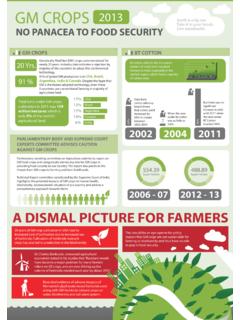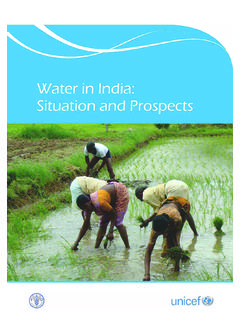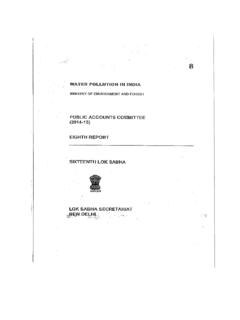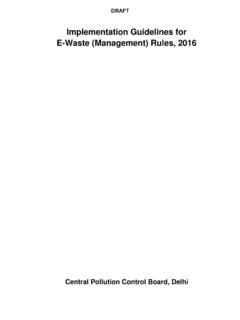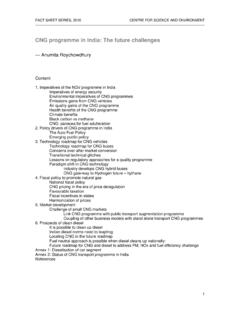Transcription of NATIONAL AIR QUALITY INDEX - indiaenvironmentportal
1 NATIONAL AIR QUALITY INDEX . Central Pollution Control Board ( ministry of Environment, Forests & Climate Change). Government of India Website: October 2014. CPCB, 200 Copies, 2014 (English). This report is prepared based on the recommendations of the Expert Group constituted by Central Pollution Control Board (CPCB), and is being released for seeking public views/comments. The report is also available on CPCB's website, Published by : PR Division on behalf of Dr. Akolkar, Member Secretary, CPCB, Delhi-110032. Printing Supervision & Layout : Shri Shriance Jain, Ms. Anamika Sagar & Shri Satish Kumar Printed at : Chandu Press, New Delhi-110092.
2 Ii iii MESSAGE. v FOREWORD. vii Acknowledgement This project, NATIONAL Air QUALITY INDEX (IND-AQI) was awarded by Central Pollution Control Board (CPCB), Delhi to Indian Institute of Technology Kanpur, Kanpur. For this project, CPCB constituted an Expert Group under the Chairmanship of Dr. A. K. Agrawal, Professor Emeritus & Ex Dean, Maulana Azad Medical College, New Delhi. The other members of the group were drawn from academia, medical fraternity, research institutes, ministry of Environment, Forests & Climate Change, advocacy groups and CPCB. The group deliberated, discussed and devised consensus on the proposed AQI system.
3 The group oversaw the progress of the project on a continual gratefully acknowledge the support and guidance of all members of the group received towards completion of this project. We are thankful to Shri Susheel Kumar, Chairman, CPCB and Dr. A. B. Akolkar, Member Secretary, CPCB. for showing con dence in us by awarding this study to IIT Kanpur; their suggestions and concerns were thoughtful and workable. Thanks are due to Dr. Prashant Gargava of CPCB for detailed discussions, posing challenges and keeping a tight leash for timely completion of the project. We thank Swapnil Mahajan, Sagar Parihar, Rajesh Singh, Kritika Upadhyay and Quazi Ziaur Rasool (Graduate Students, IIT Kanpur) for helping in literature review and developing online AQI dissemination system.
4 Mukesh Sharma; PhD and Arnab Bhattacharya; PhD. Indian Institute of Technology Kanpur, Kanpur ix Executive Summary Awareness of daily levels of air pollution is important to the citizens, especially for those who suffer from illnesses caused by exposure to air pollution. Further, success of a nation to improve air QUALITY depends on the support of its citizens who are well-informed about local and NATIONAL air pollution problems and about the progress of mitigation efforts. Thus, a simple yet effective communication of air QUALITY is important. The concept of an air QUALITY INDEX (AQI) that transforms weighted values of individual air pollution related parameters ( SO2, CO, visibility, etc.)
5 Into a single number or set of numbers is widely used for air QUALITY communication and decision making in many countries. After reviewing literature (on AQI), air QUALITY monitoring procedures and protocols, Indian NATIONAL Air QUALITY Standards (INAQS), and dose-response relationships of pollutants, an AQI system is devised. The AQI system is based on maximum operator of a function ( selecting the maximum of sub- indices of individual pollutants as an overall AQI). The objective of an AQI is to quickly disseminate air QUALITY information (almost in real-time) that entails the system to account for pollutants which have short-term impacts.
6 Eight parameters (PM10, , NO2, SO2, CO, O3, NH3, and Pb) having short-term standards have been considered for near real-time dissemination of AQI. It is recognized that air concentrations of Pb are not known in real-time and cannot contribute to AQI. However, its consideration in AQI calculation of past days will help in scrutinizing the status of this important toxic. The proposed INDEX has six categories with elegant colour scheme, as shown below. Good Satisfactory Moderately polluted Poor Very poor Severe (0-50) (51-100) (101-200) (201-300) (301-400) (> 401). A scienti c basis in terms of attainment of air QUALITY standards and dose-response relationships of various pollutant parameters have been derived and used in arriving at breakpoint concentrations for each AQI category.
7 It is proposed that for continuous air QUALITY stations, AQI is reported in near real-time for as many parameters as possible. For manual stations, the daily AQI is reported with a lag of one week to ensure manual data are scrutinized and available for AQI. AQIs must be identi ed if these are from continuous or manual station to maintain uniformity and clarity on sources of data. A web-based AQI. dissemination system is developed for quick, simple and elegant looking response to an AQI query. The other features of the website include reporting of pollutant responsible for INDEX , pollutants exceeding the standards and health effects.
8 Xi Contents Title Page No. Chapter 1: Introduction 1. Origin and concepts of Air QUALITY INDEX 1. Applications of Air QUALITY INDEX 1. Project Conceptualization 2. Project Objectives 3. Scope of Work 3. Chapter 2: Air QUALITY INDEX : A Review 5. De nition of Air QUALITY INDEX 5. Structure of an INDEX 5. Indices in the Literature 7. Current Status of AQI Application in India 11. Eclipsing and Ambiguity 11. Chapter 3: Development, Implementation and Dissemination of AQI 13. Indian Air QUALITY INDEX (IND-AQI): Proposed System 13. Air QUALITY Monitoring and AQI Considerations 15. Computation of sub-indices and AQI 16.
9 Interpretation of Air QUALITY using IND-AQI: an example 27. Web-based AQI Dissemination 32. Conclusions and Protocols 35. References 36. Appendix-I 40. xiii List of Tables Table No. Title Page No. Break Point Concentration of Green INDEX 7. Descriptor categories for Ontario API 8. Break Point Concentrations of ORAQI 9. Break point concentrations for GVAQI 10. Break Point Concentrations of MURC INDEX 11. Indian NATIONAL Air QUALITY Standards 13. AQI category and Range 14. Breakpoints for CO 18. Breakpoints for NO2 19. Breakpoints for PM10 21. Breakpoints for PM 22. Health Outcomes Associated with Controlled Ozone Exposures [WHO 23.]
10 2000]. Breakpoints for OZONE 24. Breakpoints for SO2 25. AQI Breakpoints for NH3 and Pb 26. Proposed Breakpoints for AQI Scale 0-500 26. Health Statements for AQI Categories 27. List of Figures Figure No. Title Page No. Formation of an Aggregated Air QUALITY INDEX 5. Ambiguity characteristic of Indices 12. Eclipsing characteristic of Indices 12. Overall AQI system 14. Online monitoring station (ITO, New Delhi) 15. CO Concentration and COHb level in Blood 17. Symptoms Based on COHb Level Source: CPCB 17. Web-based AQI Query: Reporting and Display 33. Menu-based AQI Query and display 34. xiv Chapter 1.
